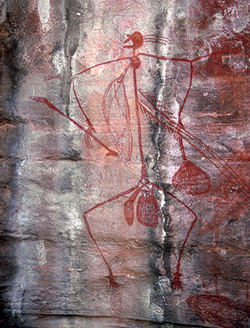Rock art in Northern Australia

Early rock painting at Ubirr, Northern Australia
From MMOA’s Timeline of Art History
The Metropolitan Museum of Art’s Timeline of Art History has a section on the history of art in Australia. Most fascinating for me was reading about the “X-ray” style in Arnhem Land rock art. This style of Australian Aboriginal art is fairly familiar in contemporary work, but I did not know it was called “X-ray” and that it is so ancient, reflecting an unbroken continuity with the ancient X-ray tradition.
The “X-ray” tradition in Aboriginal art is thought to have developed around 2000 B.C. and continues to the present day. As its name implies, the X-ray style depicts animals or human figures in which the internal organs and bone structures are clearly visible. X-ray art includes sacred images of ancestral supernatural beings as well as secular works depicting fish and animals that were important food sources. In many instances, the paintings show fish and game species from the local area. Through the creation of X-ray art, Aboriginal painters express their ongoing relationships with the natural and supernatural worlds… X-ray paintings occur primarily in the shallow caves and rock shelters in the western part of Arnhem Land in northern Australia.
Have a look at the great images.
One of the best known galleries of X-ray painting is at Ubirr, some of which may be from as far back as 40,000 B.C.! More beautiful images here.
(via bellebyrd )
An earlier post about Australian Rock Art.
September 18, 2005 in Rock Art & Archaeology by Marja-Leena
Thanks for the Met Link Marja-Leena. As gripping as it is visually, rock art such as this is to me preternaturally forgein. I will never have the sense of “getting it”. Ineffable. I feel a little closer to the rock art of the North American southwest.
Thought of you here:
http://www.ldeo.columbia.edu/edu/dees/courses/v1001/images/archaeopteryx1.gif
That’s a great image, Bill, it looks like a fossil, but perhaps man-made? Reminds of the fossils that I photographed at the fabulous Royal Tyrrell Museum in Alberta, some of which were used in some prints in the Paths series and later.
Oh, sorry, that’s a fossil Archeopteryx, the Berlin Archeopteryx. Surpassing human carving by worlds.
I have happened on more B.C. pictograph material with which you are likely familiar. Do wish I had access to a good library. This site lists some interesting titles:
http://www.vaseuxlakelodge.com/picto1.html
I would like to edge closer to this mystery, communion and communication practice. To write upon the earth itself, that act is a focus for contemplation. It is to submit to the relative permanence of great stone mountains and bluffs, while facing how brief and transient a human life is. Painful perhaps, but sustaining as well.
I believe even contemporary stone sculpture carving disregards the rock’s age and connection to the great vast ages and spaces, favoring an involvement with distractions of process, illusion and conceit of design. Good rock art is worked out of quarry-stone with predictable and regular physical characteristics. The rock becomes stone; a material, a sort of plastic substance.
Hope I am not to wooly here. There is an interesting difference, though between “rock” and “stone”. I had never heard of the term “rock art” before coming to your site. Thanks
Forgive me for presuming that you are interested and for scribbling on your comments as if my own scrap paper:
http://www.rock-art.com/books/region.htm
As my mind continues to clunk along (I am not able for long to hold a focus my own ephemerality) I come to Jimmie Durham, whose central theme has been a sort of revengne of the rock. Rock destroying Whitey’s gadgets of culture. Durham is, by no happenstance, a native Cherokee (I could be wrong here). He is a very interesting conceptualist. On my books to read list is the author Michael Taussig, a writer on image society and magic. Jimmie Durham is well introduce by a Google image search. In case you are tempted here is a starter image:
http://www.undo.net/Pressrelease/foto/1088169214b.jpg
Sorry again and Thanks!
Marja-Leena, me again. Do you have a recommendation for a Rock Art book? Do you know the Thor Conway books?
Bill, you are really good at rooting out great links to share and discuss – no apologies needed, just my thanks.
That particular Vaseux Lake link is new to me and just great, I’ve only seen small mentions elsewhere. I love what you say about the making of art on the earth, and the difference between rock and stone. It’s not woolly at all. You’ve voiced a feeling that I’ve long had and not been able to express this way.
The Pietra Pintada book list is excellent, I saw one a few years ago and have forgotten it, and it’s updated. I’m not familiar with Durham and Taussig, but will look for them when I have some idle time. As for book recommendations, you read about Spirit in the Stone, and I also have Jean Clottes’ Chauvet Cave sitting here waiting for me. I wrote about one writer’s recommendations here. I’ve also just ordered a couple of Finnish books on rock art in Finland and Sweden but it may take a while before I get them, read then write about them. Just wish I had more time to read!
Have you found that a Google search for rock art comes up with rock music links !? 🙂
Oh,Bill, I forgot to say that I don’t recall the name Thor Conway. He writes books about rock art, does he?